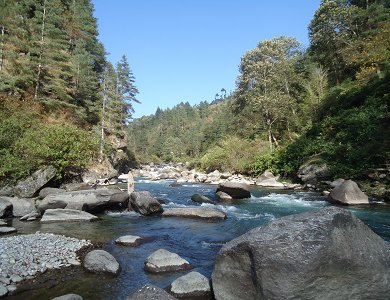
After almost four years of painful efforts, Prabin Shrestha, Managing Director of Upper Solu Hydro Electric Company, has been heaving a sigh of relief as he managed to sign the financial closure of the 23.5 MW, run-off-the-river Solu project. A reputed industrial group, ICTC now has its entire prestige involved in the project implementation.
“Although we have faced many difficulties in various stages of the project since we secured the bidding in open tender in 2010, we have won the first battle after the financial closure. However, there may appear certain hurdles in future given the present state of construction process of transmission lines by NEA,” said Shrestha.
At a time when private sector financed projects Mai Khola, Misti and many others are facing difficulties in implementation, giving a frustrating picture, the financial closure of Solu Hydro Electric Project, one of the super six projects, has generated new hopes. If things go normally, Solu will generate electricity by 2018.
Despite the projection by Nepal Electricity Authority, Nepal’s electric grid will continue to be starved of power for many years to come. Even if there is the production of surplus energy, the recently agreed Power Trade Agreement between Nepal and India is likely to open the market for Nepal’s surplus energy.
The timing of the signing of the financial closure of Solu Hydroelectric Project is also significant as Nepal and India have signed the initial of Power Trade Agreement (PTA) and Nepal Investment Board and GMR International India have also signed Power Development Agreement on Upper Karnali project, which is also given in international bidding.
Shrestha, Managing Director of Upper Solu Hydro Electric Company (USHEC) and ICTC Group, signed a loan to conclude the financial closure for the development of Solu Hydroelectric project with the consortium of banks and financial institutions led by CEO of Laxmi Bank Sudesh Khaling and representatives of other banks and a financial institution.
A consortium of eight banks and a financial institution led by Laxmi Bank will finance the 23.5 MW, run-off-the-river, Solu Hydro-Electric Project which will be constructed at Solu Khola in Solukhumbu district.
Constructed under financial model of 75:25, the total project cost is 4100 million rupees with loan amount of 3,075 million rupees and the payback period of 5.84 years. With the Power Purchase Agreement of 30 years, the project construction period will be 42 months and PPA price will be at Rs. 4.80 per KWh during wet and Rs.8.40 per KWh during dry season with 5 percent escalation at 3 percent per year (simple interest).
According to financial parameters the project, the loan repayment period is 11 years after COD with 12 percent interest rate average long term. The banks and financial institution, which expressed the commitment to the project, include Laxmi Bank (Rs. 500 million), Nepal Investment Bank (Rs.500 million), NMB (Rs. 500 million), Everest Bank (Rs.400 million), NIC-Asia Bank (Rs.341.25 million), Global IME Bank (Rs 195 million), Lumbini Bank (Rs.195 million), Century Commercial Bank (Rs.243.75 million) and Hydroelectricity Investment and Development Co. Ltd or HIDCL (Rs. 200 million).
Led by CEO Shashi Sagar Rajbhandari, USHEC is an undertaking of ICTC group’s energy establishment ICTC Energy Pvt. Ltd. Developed at a cost of 4.1 billion rupees, USHEC had signed the Power Purchase Agreement (PPA) with Nepal Electricity Authority (NEA) on November 10, 2013 and it received generation license from Ministry of Energy on March 27, 2014.
According a press release, the lenders have committed to finance 75 percent of the project cost with the remaining 25 percent invested by the promoters among which the ICTC group holds 80 percent and Blue Energy Pvt. Ltd 20 percent.
Solu HEP is the first Super Six project to conclude the financial closure and is in advanced state of development even among these six projects. The basic infrastructure of the project is already under construction and work main structures is scheduled to start from the beginning of the year 2015.
“It is a matter of pleasure for all the persons involved in the hydro-power development. It will definitely send a good message to the developer that something can be done,” said Prabin Shrestha, who spent a lot of energy and time to rescue the project.
Through Department of Electricity Development, Nepal government had initiated awarding the eight projects (varying in capacity from 5 MW to 40 MW) including Solu Hydroelectric Project. The project was awarded through the competitive bidding. After a thorough evaluation, the six projects were awarded to six private companies.
“Our installed capacity is 23.5 MW and we expected the project to contribute around 132.52 GWH when it comes into operation in July 2018,” said Shrestha.
At a time when the country has been passing through a political transition, USHEC has shown the courage to invest in the power project. If the project goes smoothly and the government and NEA fulfill their commitments, Solu Hydro-Electric Project will establish a model for successful Public-Private Partnership in energy sector.

Keshab Poudel
Poudel is the editor of New Spotlight Magazine.
- ECONOMY: Growth At 3.3
- Apr 16, 2024
- DPM’s SHRESTHA’S CHINA VISIT High Profile, Low Key
- Apr 14, 2024
- Maha Kumbha In Barahkshetra: A Sacred Festival In Sacred Koshi (Kaushiki) River
- Apr 09, 2024
- LOSS AND DAMAGE: Upper Tamakoshi A Case
- Apr 02, 2024
- Helvetas-Nepal’s InElam Promoting Herbal Oil In Sarlahi
- Mar 31, 2024
















